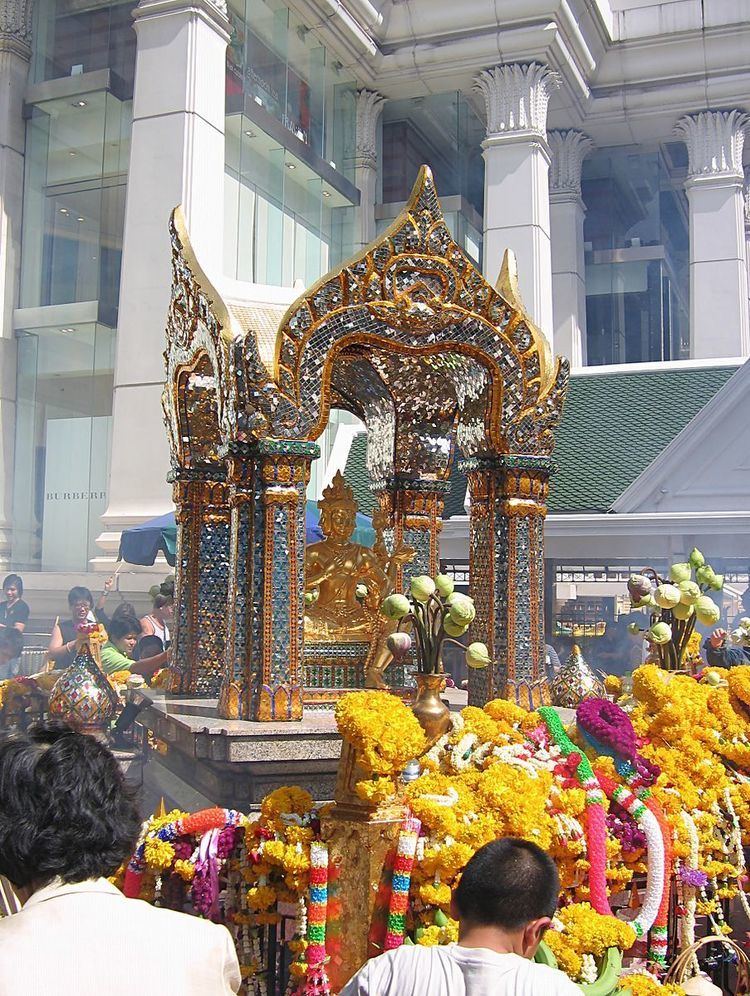Opened 1956 | Phone +66 2 254 1234 | |
 | ||
Similar Ratchaprasong, CentralWorld, Wat Arun, Grand Palace, Chit Lom BTS Station | ||
Erawan shrine bangkok thailand
The Erawan Shrine, formally the Thao Maha Phrom Shrine (Thai: ศาลท้าวมหาพรหม; rtgs: San Thao Maha Phrom; "Shrine of Lord Brahma the Great"), is a Hindu shrine in Bangkok, Thailand, that houses a statue of Phra Phrom, the Thai representation of the Hindu god of creation Lord Brahma. A popular worship attraction, it often features performances by resident Thai dance troupes, who are hired by worshippers in return for seeing their prayers at the shrine answered.
Contents
- Erawan shrine bangkok thailand
- Evening prayer at erawan shrine bangkok
- Location
- History
- 2006 vandalism
- 2015 bombing
- References
On 17 August 2015, a bomb exploded near the shrine, killing 20 and injuring 125 more.
Evening prayer at erawan shrine bangkok
Location
The shrine is located by the Grand Hyatt Erawan Hotel, at the Ratchaprasong intersection of Ratchadamri Road in Pathum Wan district. It is near the Bangkok Skytrain's Chitlom Station, which has an elevated walkway overlooking the shrine. The area has many shopping malls nearby, including Gaysorn, CentralWorld and Amarin Plaza.
Five other shrines dedicated to Hindu deities are located in the area as well: Phra Laksami (Lakshmi), Phra Trimurati (Trimurti), Phra Khanet (Ganesha), Phra In (Indra), and Phra Narai Song Suban (Narayana on his garuda).
History
The Erawan Shrine was built in 1956 as part of the government-owned Erawan Hotel to eliminate the bad karma believed caused by laying the foundations on the wrong date.
The hotel's construction was delayed by a series of mishaps, including cost overruns, injuries to laborers, and the loss of a shipload of Italian marble intended for the building. Furthermore, the Ratchaprasong intersection had once been used to put criminals on public display.
An astrologer advised building the shrine to counter the negative influences. The Brahma statue was designed and built by the Department of Fine Arts and enshrined on 9 November 1956. The hotel's construction thereafter proceeded without further incident. In 1987, the hotel was demolished and the site used for the Grand Hyatt Erawan Hotel.
2006 vandalism
In the early hours of 21 March 2006, the shrine was vandalised by a Thai man believed to be mentally ill. After smashing the statue with a hammer, 27-year-old Thanakorn Pakdeepol was beaten to death by angry bystanders. Two street sweepers who worked for the Pathum Wan District office were arrested and charged with the fatal beating.
Witnesses said Thanakorn stood on the base of the statue with a large hammer in his hands, and smashed the hollow statue of Brahma to pieces. The deity's four-faced head, torso, six arms and weapons were fragmented. Only part of the lap and base of the statue were left intact. The incident occurred at about 01:00. A white cloth was used to conceal the absence of the statue. Officials later reopened the site to the public, displaying photographs of the statue so worshippers could pay their respects.
During the autopsy of Thanakorn Pakdeepol, doctors found Arabic characters tattooed on his back and arms, prompting police to investigate if the attack had a religious motive and if the vandal or his family had ties to Muslim extremists. However, the slain man's father, Sayant Pakdeepol, said his son had received treatment for psychiatric problems and that mental illness was the cause of the attack. Sayant described the fatal beating of his son an "overreaction". "Doing something like this is not the act of people with good beliefs, of those with real faith in Brahma", Sayyant told The Nation newspaper. "Murder is an immoral act and people with morality would not have done what they did".
In the days immediately after the destruction of the Erawan Shrine, then Thai Prime Minister Thaksin Shinawatra visited and paid his respects to the broken fragments of the Hindu deity.
The new Brahma statue was placed in the shrine on 21 May 2006 at 11:39, the moment the sun was shining directly above the shrine. Officials with the Religious Affairs Department and the Maha Brahma Foundation said it was made of plaster, mixed with a mixture of gold, bronze and other precious metals, along with fragments of the original statue. Another duplicate statue, made entirely of metal, was cast in the same mold, and is kept in the national museum.
At an anti-Thaksin rally on the following day, government critic Sondhi Limthongkul charged the destruction of the statue was a plot by the admittedly superstitious Thaksin to maintain his political power through black magic. However, Thanakorn's father rejected the claim, telling The Nation that Sondhi "is the biggest liar I have ever seen." When asked to comment the accusation, Thaksin simply replied, "That's insane."
2015 bombing
On 17 August 2015, at 18:55 local time, an explosive device composed of three kilograms of TNT stuffed in a metal pipe and wrapped in white cloth inside a backpack, detonated near Erawan Shrine, killing 20 people and injuring 125. Bomb disposal units checked two suspicious objects but found no other bombs. As of 26 August, no one has claimed responsibility for the act and the investigation is ongoing. The bombing is suspected to have been carried out by the Pan-Turkic Turkish ultra-nationalist organization Grey Wolves in retaliation for Thailand's deportation of Uyghur terrorist suspects back to China instead of allowing them to travel to Turkey for asylum.
The bomb was placed in the shrine grounds next to a metal railing. The statue was slightly damaged. Within two days all repairs had been completed and the shrine reopened. Rather than being commended for the swift reopening of the shrine, the government's actions have been subject to criticism. The government's perceived lack of progress in the investigation has stimulated critics to propose a number of theories as to who is responsible for the bombing, including elements of the government itself.
